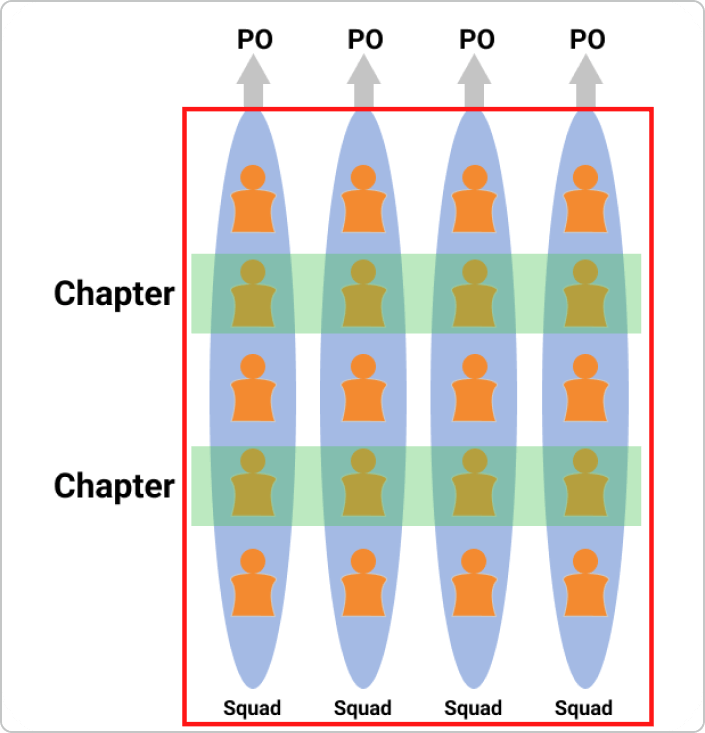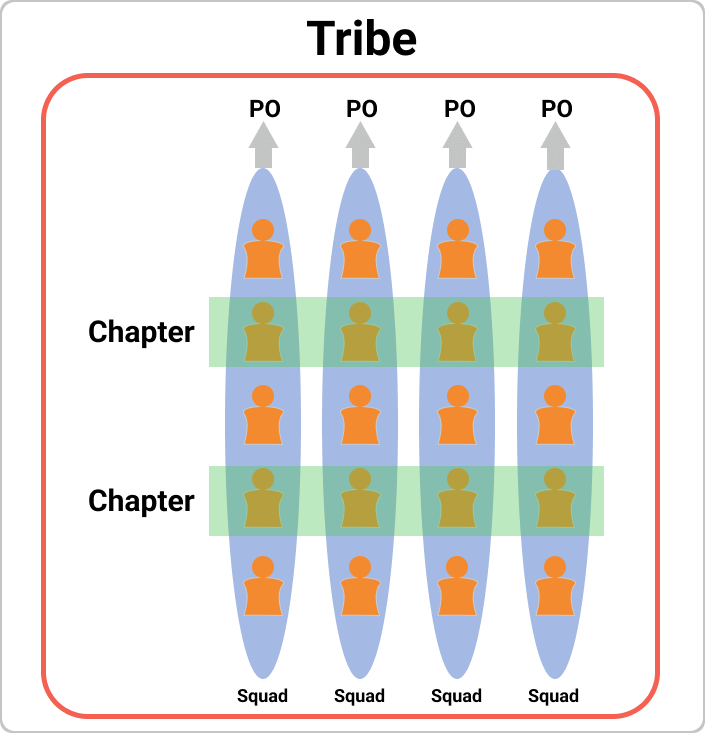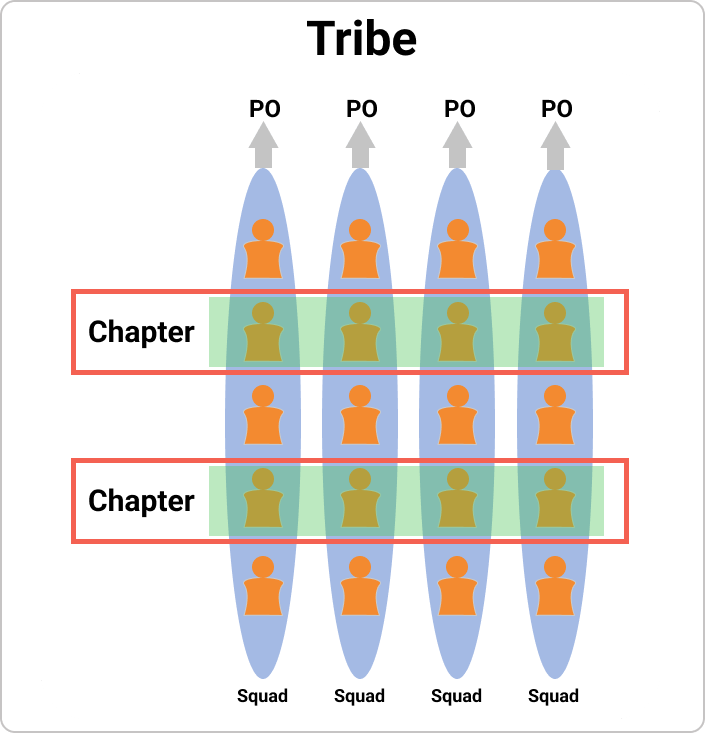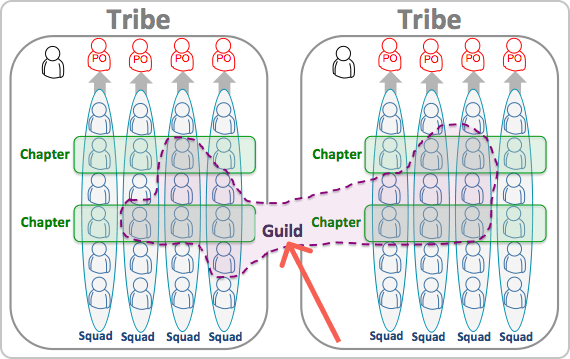Imagine a company where teams operate like mini-startups, empowered to own their ideas and iterate at lightning speed. This is the reality brought to life by the Spotify Model. Let's uncover all the essentials of the famous model behind Spotify's Agile transformation.
Understanding the Spotify Model
The Spotify model represents a work structure the company created to scale its adoption of Agile across the organization. At its core, the model is an autonomous, people-driven approach that emphasizes the importance of culture, communication, and network within the company. It is designed to promote collaboration, transparency, and simplicity, aligning team members into roles where they can make the most significant impact.
Hendrik Kniberg and Adres Ivarsson first popularized it in a whitepaper from 2012. They provide an overview of how Spotify organized multiple product development teams and scaled Agile practices across them, aiming to improve product delivery processes.
How the Spotify Model Fits into Agile Methodologies?
By organizing cross-functional teams into 'squads' that function like mini-startups, the Spotify model empowers teams to own their products, make decisions rapidly, and iterate quickly, which is essential for Agile methodologies to thrive at scale. The model's focus on autonomy also fosters a creative and innovative environment where accountability and quality are inherently valued by each squad.
What Is the Importance of the Spotify Model in Agile Development?
The Spotify model gives a real-life example of how a company can disperse Agile principles and practices across an organization. It's important in Agile project management as it doesn't prescribe a particular method or framework to be followed but focuses entirely on driving enterprise agility. After all, this is what every company's goal should be as a result of adopting Agile practices, regardless of the exact work management approach they use to reach it.
What Are the Key Elements of the Spotify Model?
The Spotify model is built around a specific structure of Agile product development teams that consists of the following key elements:
Let's look at each one in more detail and how they relate to one another.
1. Squads
The squad represents the basic unit of development in Spotify. There are multiple squads within the company. You can think of them as a small group (usually 6-12) of cross-functional people dedicated to working on a single feature area. This could be the payment solutions, the ability to download and discover music, the platform's development on a specific mobile OS such as Android, etc.

The squads are self-organized, and they are free to choose the Agile method, framework, etc., that they think would work best in their scenario (ex. Kanban, Scrum, Scrumban, etc.). The squad members sit together and are composed of people who have the necessary skills (including tools) to release new functionalities on production with a minimum amount of dependencies. They are characterized by autonomy to make their own work decisions and the fact that they operate in an open environment where there is a strong focus on knowledge sharing.
It's important to mention that a squad doesn't have a dedicated leader, but it has a product owner (PO). Like in the Scrum framework, the PO is responsible for capturing customer requirements (internal or external) and prioritizing the work backlog. Product owners are not involved in the way the squad does their work. Still, they are required to communicate a high-level roadmap of Spotify's product strategy and maintain their dedicated product backlog.
Other than that, squads usually have an Agile coach responsible for the continuous evolution of Agile principles and practices through Agile retrospectives, planning and coaching sessions, etc.
One of the key elements of every Spotify squad is that they maintain direct contact with stakeholders to minimize the burden of dependencies. They also run regular surveys to identify where organizational support is needed so their dedicated work can flow smoothly from concept to fruition.
2. Tribes
The next structural level in Spotify is known as tribes. They represent a collection of squads (working on related features) within a wider product area. Some examples are all the squads that work on different features within the music player in Spotify, the company's mobile app, frontend, or backend infrastructure.

The tribes in Spotify consist of 40-100 people, dispersed across different squads. In contrast to the squads, tribes have their leaders. They are responsible for maintaining a collaborative environment, but most importantly, their role is to create work alignment across all squads. This entails managing squad dependencies and ensuring a smooth flow of work across the tribe structure. The squads in a tribe are located in the same office space with lounge areas that promote cross-squad collaboration.
A key characteristic of tribes is that they hold regular informal gatherings where every squad shows the rest what they are working on, the progress on different functionalities, and some lessons learned from previous releases. This can happen through product demos, digital presentations, roadmaps, etc.
It's important to mention that other than squads, often there are cross-tribe dependencies that are critical to be managed. Otherwise, they can lead to blockers that hinder the smooth flow of work. To do this, tribes hold their dedicated surveys to identify patterns in cross-tribe dependencies. Then, tribe leads engage in on-demand meetings to look for ways to eliminate those dependencies or reduce their impact.
3. Chapters
The chapters in Spotify represent a group of people with a similar competency area within a single tribe. So, for example, the business analyst among multiple squads can set up a single chapter, the testers can create another one, and so on. You can think of this as the "glue" that keeps the different squads within a tribe connected and promotes a collaborative culture.

The chapter members set up their meetings where they get together to share knowledge and ideas within their specific area of expertise. This allows the squads to continuously optimize their work, test new tools, experiment with innovative approaches, etc., which benefits the overall work delivery process.
Every chapter has its own leader, usually a functional manager (ex. R&D manager). The dedicated person is responsible for maintaining best practices among the specific area of expertise. However, they're also an active part of a squad and are part of the day-to-day work activities.
4. Guilds
Guilds are formed around groups of people with a broad "area of interest". Unlike chapters, they can span across multiple squads or tribes and include professionals from the entire organization. An example is the Agile coach guild, the Testers guild, etc. It's important to mention that it's not a requirement for a guild to be formed around specific job roles. For example, there could be a wider "project management" guild that different professionals interested in that area are free to join.
 Image Credit: Scaling Agile@Spotify (blog.crisp.se)
Image Credit: Scaling Agile@Spotify (blog.crisp.se)
There isn't a dedicated leader of a guild. However, " coordinators " are responsible for organizing guild meetings, setting agendas, etc. One specific example of a guild is the "Agile coach" community within Spotify. Their members from the entire organization meet regularly to discuss best practices or challenges across their squads. They also have a dedicated improvement board to track the progress of different Agile improvement initiatives within Spotify.
5. Trio
In Spotify, the trio represents a combination of a tribe, product, and design leaders within a single tribe. It's a good practice for each tribe to have their dedicated trio, which ensures improved workflows when squads are working on different feature areas. This happens because of the alignment between product and design-related areas and the dependencies between squads.
6. Alliance
Multiple tribes might need to work together to accomplish a given goal. In such cases, the different tribe trios form an "Alliance". The responsibility of an alliance is to help tribes work together toward a larger strategic goal.
What Are the Benefits of the Spotify Model?
Some of the main benefits of the Spotify model for scaling Agile include:
- High Levels of Transparency & Team Collaboration - The Spotify model promotes an open environment and transparency in the operations of all teams. The organization into squads, tribes, chapters, and guilds creates a truly collaborative environment that helps Spotify accelerate innovation.
- Team Autonomy & Improved Efficiency - Every squad inside Spotify is an autonomous entity at the company that is responsible for producing customer value. The Spotify model breaks down the traditional top-level management structure and cascades power to the professionals while promoting collaboration. This increases team morale, improves efficiency, and speeds up market delivery.
- Minimized Negative Effect of Dependencies - Every squad in Spotify consists of cross-functional specialists with the necessary skills to release functionalities to production. Due to the regular surveys across people in squads and tribes, Spotify can keep a clear overview of their dependencies. This allows them to identify dependencies that cause blockers and look for ways to minimize their effect on the workflows.
- Less Formal Processes - The formal processes are minimized in Spotify thanks to the work organization around product areas instead of specialties. This gives more flexibility to Squads to quickly change their direction and take on new priorities whenever necessary.
- High Employee Satisfaction - According to a survey led by Spotify, 91% of employees report feeling happy at the company. In addition, due to the Spotify model of work organization that promotes a collaborative and open environment, employees feel a sense of belonging to the company, increasing their motivation.
What Are the Limitations of the Spotify Model?
Some significant limitations of the model are provided below.
- Not a Universal Solution - Contrary to what some people believe, the Spotify model is far from a universal solution for scaling Agile. Instead, it's a unique approach that was developed based on Spotify's company culture, work processes, and dedication to embracing organizational agility. That's why blindly copying it and applying it to other organizations will probably not work as intended. The idea of the Spotify model is to provide an overview of how organizing work around delivering outcomes (not outputs) can accelerate a company's development. However, the actual execution should be tailored to your situation.
- System Architecture Risk - The squad organization around specific product functionalities can create risks for the company's system architecture. That's because once a squad updates one system, they often need to implement changes to several more too. This hides risks for architectural defects when many squads focus only on small chunks of the system at a time. That's why it's important to have a dedicated System Owner who maintains the integrity of the product architecture.
What Are the Best Practices of the Spotify Model?
1. Adjusting the model to your organizational needs. The most important best practice when applying the Spotify model is not to copy it. Instead, you should understand the structure and mindset behind how Spotify scales Agile. Then, focus on finding your organization's needs and tailoring the model to your unique environment.
2. Building the right mindset. Furthermore, building a culture around self-organization, respect for people, and trust is extremely important for successfully applying your own variant of the Spotify model.
3. Promoting transparency and learning. Ensure you promote transparency where everybody's opinion counts, as well as a no-blame work environment where mistakes are seen as learning opportunities rather than failures.
How Is the Spotify Model Different from other Scaled Agile Frameworks?
The Spotify model is neither a framework nor a method and it's completely different from frameworks for scaling Agile such as SAFe, LeSS (Large-Scale Scrum), Scrum@Scale, etc. The main difference is that the Spotify model doesn't prescribe a structure to re-organize your teams, introduce new roles, or a specific approach to managing work (such as Scrum or Kanban).
Instead, the model provides an overview of how Spotify assessed their culture and decided to continue scaling Agile in their unique environment. The main takeaway from this article is to take the concept that Spotify introduced and figure out how to tailor it to your own company without copying what somebody else did and expecting the same result.

Nikolay Tsonev
Product Marketing | PMI Agile | SAFe Agilist certified
Nick is a seasoned product marketer and subject matter expert at Businessmap, specializing in OKRs, strategy execution, and Lean management. Passionate about continuous improvement, he has authored numerous resources on modern-day management. As a certified PMI practitioner and SAFe Agilist, Nick frequently shares his insights at Lean/Agile conferences and management forums.



